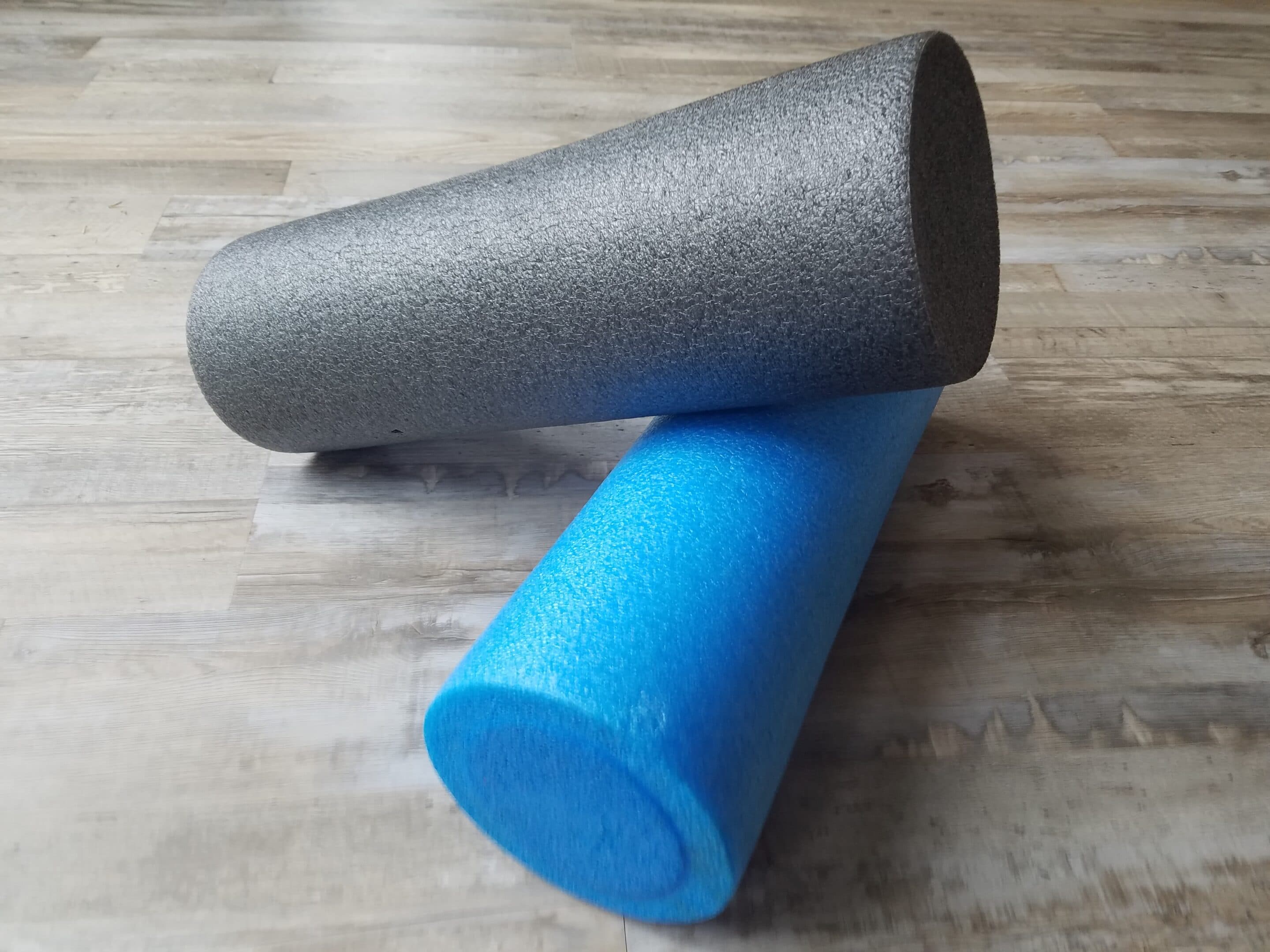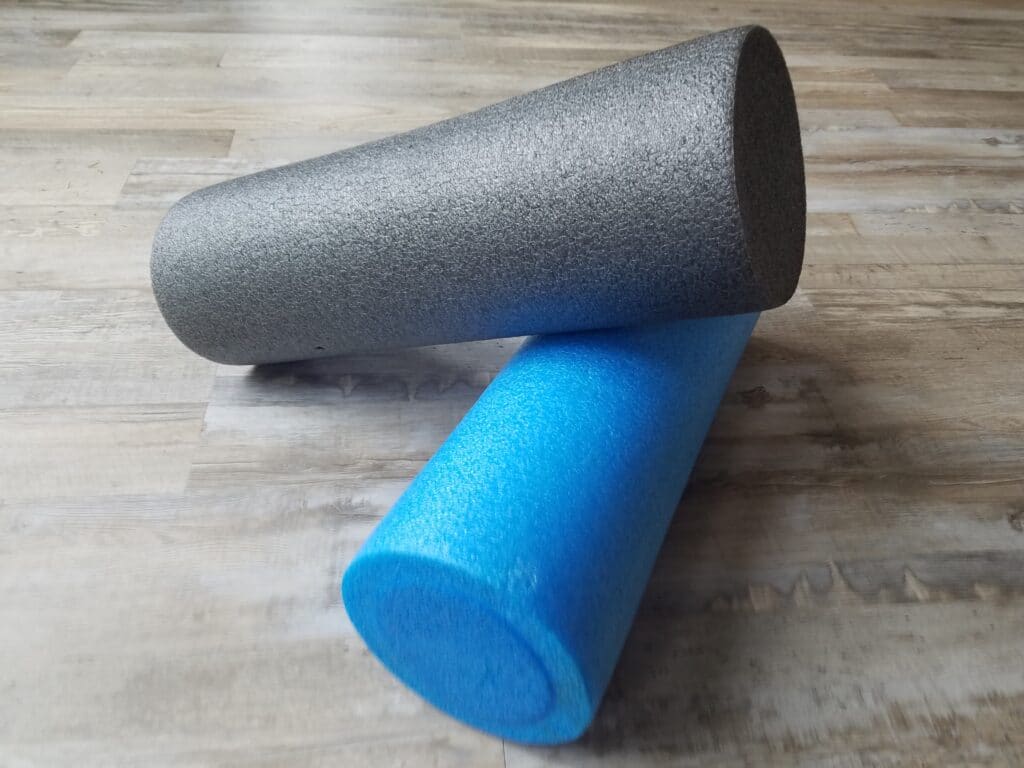Become a More Flexible Senior Triathlete By Foam Rolling

Foam rolling is a great tool for increasing flexibility and improving recovery.
I was first reminded of this while at the health club a few years ago. I was halfway through the stretching routine used after running or cycling. It includes stretching and foam rolling to loosen the muscles and tendons.
The lady next to me was also using a foam roller. After finishing this portion of her routine, she asked me “Is it possible to use the foam roller too much?”
I answered with my experience, that my body tells me when I had rolled enough. My muscles either felt loose or one or more of them hurt while I continued to use the foam roller.
She told me that near the end of one of her sessions with a personal trainer a few years ago, she asked the trainer if he ever used a foam roller. He had replied “I foam roll after every one of my workouts.”
Of course, she wondered why he had never introduced her to the foam roller.
Now, she was using foam rolling without the benefit of knowing how to get the best results.
My Next Reminder to Use a Foam Roller
Even before that experience, I had struggled with a sore right hip. While simply standing still, the pain from my hip ran down my leg, making it painful to stand or walk slowly, like when grocery shopping.
A physical therapist had diagnosed this as weakness of small muscles in my glutes, and prescribed a series of leg lifts which I continue as part of my strength training sessions today. However, over the past year, I noticed the pain running down my right leg while standing, shopping, and even dancing. Oddly, I never felt this pain when running.
Stretching my back, which had also been prescribed by the physical therapist, didn’t help eliminate the pain.
Then, one day, while massaging a tight area in the upper part of my right glute, I noticed a tenderness. This reminded me of times I had used the foam roller to treat other painful areas, most notably my knees.
Sure enough, the first time I laid the tight area on my foam roller, my eyes felt as if tears were forming. Over the next couple of sessions of foam rolling, the tightness disappeared. I could no longer find a place on my glutes that hurt during foam rolling. As before, the pain in my leg while standing and dancing has disappeared.
What is a Foam Roller?
Foam rollers are cylinders of solid foam like those pictured below. They come in various lengths. They also come in various densities (hardness) of foam. Some foam rollers are smooth, while others have ridges. The ridges concentrate weight to apply greater pressure during use.

The foam roller is a convenient, at-home alternative to a massage for loosening muscles, tendons, and the myofascial tissue surrounding them before and/or after a workout to prevent injury or eliminate soreness and stiffness.
My introduction to foam rolling came when treating an IT (iliotibial) band tightness that was creating pain in my left knee while running. After some painful sessions with the foam roller, both IT bands became loose, and the pain disappeared. I have not had a recurrence of this pain since continuing foam rolling.
What Type of Foam Roller is Best for Flexibility?
If you are new to foam rolling, I suggest you begin with a medium hard roller (like the gray one pictured above). This length covers the width of the body. You will be able to roll the upper back and the hamstrings and quadriceps of both legs.
As flexibility improves, you can use the same roller on one leg at a time to get a deeper massage.
How Can You Improve Flexibility by Foam Rolling?
The internet is full of routines for improving flexibility using foam rollers. Here are two – How to Use a Foam Roller and Foam Rolling – The Basics.
My routine includes rolling the full length of the quadriceps, hamstrings, IT bands of both legs individually, and glutes individually. You may also choose to roll your upper or lower back, though I stretch these in other ways.
As you are rolling, try various positions searching for any areas that are sensitive and therefore need stretching. When I find a sensitive area, I typically hold the position until the sensitivity goes away or tears form in my eyes. I don’t really wait until tears form, but almost, to get a deep massage.
I then try to remember to go back to that area the next time I am stretching.
Final Thoughts About Foam Rolling For Flexibility
There are two main reasons I continue with triathlon training. The first reason is to maintain a healthy heart, maintaining a reasonable aerobic fitness so I can move around easily and maintain acceptable blood pressure. The three sports of triathlon provide a whole body workout and whole body fitness.
The second reason is to maintain and even improve my flexibility. I love to move about without pain. And, as I have learned recently, this flexibility is also good for the golf game I have been reintroduced to since moving to The Villages, Florida.
Be patient but consistent and, within a few weeks, the improvement in both fitness and flexibility will amaze you.
What Has Been Your Experience?
Do you use a foam roller as part of a post-workout stretching routine? Why or why not?
What has been your experience with foam rolling?
Comments: Please note that I review all comments before they are posted. You will be notified by email when your comment is approved. Even if you do not submit a comment, you may subscribe to be notified when a comment is published.
This post was originally published on December 14, 2021. I updated it after my most recent experience, one that reminded me to use the foam roller more consistently.

Perhaps you could do an article comparing foam rolling to using a massage gun.
Great idea, Joe. I also use a massage gun from time to time. Feel free to share your thoughts for the post by email at seniortriathletes@gmail.com.
There is no comparison between the two in terms of results especially if you do the cross friction rolling first and then up and down the muscle groups. — massage guns are great for pressure point stimulation but would need to spend hours doing it instead of the ten minute routine I do daily on the roller —I have 4 massage guns recovery boots and find rolling done correctly is far superior.
As we age the foam roller must be part of your daily workout routine —I use it in front of TV in the early evening —and if you want real results every muscle group should involve cross friction first then up and down the muscle groups —without the cross friction you will not recover as quickly —like most up until 2 years ago I just rolled up and down the muscles -but since flowing a protocol on I am hooked on cross friction—good luck !
Jim,
Thank you for your comments, which match my experience. They confirm the value of comparing the two methods. I hope I can include your comments in the new post.